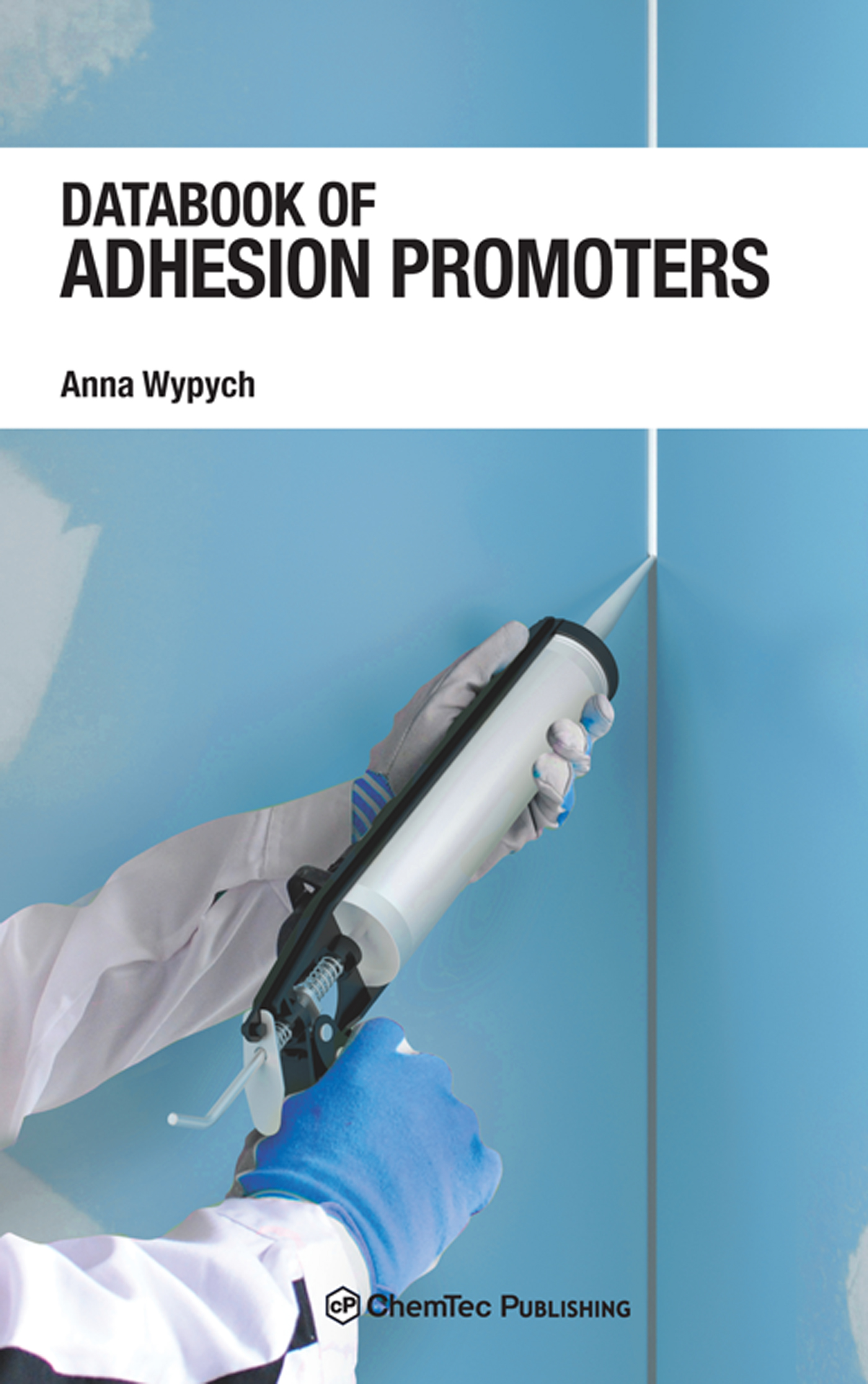Table of Contents
Landmarks
Databook of Adhesion Promoters
Anna Wypych

Copyright
Published by ChemTec Publishing
38 Earswick Drive, Toronto, Ontario M1E 1C6, Canada
ChemTec Publishing, 2018
ISBN 978-1-927885-27-7 (hardcover), ISBN 978-1-927885-28-4 (PDF)
Cover design: Anita Wypych
All rights reserved. No part of this publication may be reproduced, stored or transmitted in any form or by any means without written permission of copyright owner. No responsibility is assumed by the Author and the Publisher for any injury or/and damage to persons or properties as a matter of products liability, negligence, use, or operation of any methods, product ideas, or instructions published or suggested in this book.
Library and Archives Canada Cataloguing in Publication
Wypych, Anna, 1937-, author
Databook of adhesion promoters/Anna Wypych.
Includes bibliographical references and index.
Issued in print and electronic formats.
ISBN 978-1-927885-27-7 (hardcover).--ISBN 978-1-927885-28-4 (PDF)
1. Adhesives. 2. Adhesion. I. Title.
TA455.A34W97 2018620.199C2017-905283-7
C2017-905284-5
Printed in Australia, United Kingdom, and United States of America
Introduction
Adhesion promoters form a very important group of additives without which many industrial products (28 product groups made out of 29 different polymeric materials) cannot perform according to requirements. The present publication on this subject is mostly related to silanes, which form the most widely used group of these additives. The information on silanes is still based on the book which was published in the beginning of 1980s. Since then many new additives were introduced into the market. Many of these new additives are not based on silanes but on one of over 30 chemical groups of chemical compounds needed for a variety of products in which silanes do not function, are too expensive, or better performance can be achieved with these new additives, some of which are environmentally friendly and come from renewable resources.
Databook of Adhesion Promoters contains extensive data on the most important products in the use today. Two groups of data are included: data for some chemical compounds used for the manufacture of adhesion promoters (data included come from many available sources and contain extensive reference) and commercial products (data from a single supplier of material).
The information on each adhesion promoter included in the Databook of Adhesion Promoters is divided into five sections: General information, Physical properties, Health and safety, Ecological properties, and Use & performance. The data belong to almost 150 data fields, which accommodate a variety of data available in the source publications. The description of each section below gives more detail on the composition of information.
In General information section, the following data are displayed: name, CAS #, EC #, Acronym, Active matter, Amine number, Amine value, Chemical class, Chemical structure, Common synonym, Complexed organics, Composition, Empirical formula, Functional organic group, Functionality (average), General description, IUPAC name, Metal content, Mixture, Moisture content, Molecular formula, Molecular mass, Molecular structure, Moisture contents, Name, Number of metals, Organoreactive group, Purity, RTECS number, and Solids content.
Physical-chemical properties section contains data on State, Odor, Color, Color (Gardener), Color (platinum-cobalt scale), Acid number, Acidity, Ash content, Boiling point, Freezing point, Glass transition temperature, Melting point, Pour point, Chloride content, Cloud point, Density, Evaporation rate, Hildebrand solubility parameter, Hydrolysable chloride, Hydrolysis half-time, Hydroxyl number, Kinematic viscosity, Melt flow rate, Neutralizing agent, Nitrogen content, pH, Refractive index, Saponification value, Solubility in water and solvents, Solubility (diluents), Specific gravity, Specific heat, Sulfur content, Surface tension, Thermal decomposition products, Thermal stability (TGA), Vapor density, Vapor pressure, Viscosity, Viscosity SUS, and Volatility.
Health and safety section contains data on Autoignition temperature, Flash point, Flash point method, Explosive LEL, Explosive UEL, NFPA Health, NFPA Flammability, NFPA Reactivity, HMIS Health, HMIS Fire, HMIS Reactivity, Hazardous combustion products, Agency ratings, Hazard ingredients labelling, Hazardous hydrolysis products, UN number, UN Risk Phrases, R, UN Safety Phrases, S, DOT Class, ICAO/IATA class, IMDG class, TDG class, UN/NA hazard class, UN risk and safety phrases, ICAO/IATA Class, IMDG Class, OSHA hazard class, Rat oral LD50, Mouse oral LD50, Guinea pig dermal LD50, Rabbit dermal LD50, Inhalation rat LC50, Skin irritation, Eye irritation, Ingestion, Inhalation, Effect of repeated or overexposure, First aid: eyes, skin, and inhalation, Exposure personal protection, ACIGH, NIOSH, and OSHA exposure limits, Carcinogenicity by ACGIH, IARC, NTP, and OSHA, Mutagenicity, Teratogenicity, and Specific target organ.
Ecological properties section contains data on Bioaccumulative potential, Bioconcentration factor, Biodegradation probability, Aquatic toxicity LC50 (Green algae, Rainbow trout, Bluegill sunfish, Fathead minnow, Zebra fish, and Daphnia magna), Biological, Chemical, and Theoretical Oxygen Demand, BOD/COD ratio, and Partition coefficient (log Koc and log Kow), and Stability in water half-life.
Use & performance section contains information on Manufacturer, Outstanding properties, Potential substitute, Recommended for polymers, Recommended for products, Recommended applications, Processing methods, Concentration used, Guidelines for use, Food approvals, Alternative products, and Conditions to avoid.
The above data are given, whenever available, for approximately 400 most important adhesion promoters produced and used today.
Information on data fields
The fields used in the databook are listed in alphabetical order. The information on data in a particular field includes a glossary of term, unit of measurement, typical methods used to measure quantities available in the databook.
ACID NUMBER
Twenty-five grams of an adhesion promoter is placed in 125 ml Erlenmeyer flask and 50 ml alcohol is added to dissolve the sample. If the sample is not completely soluble, 50 ml of equal amounts of alcohol and acetone are used. This sample is titrated with 0.01N NaOH or KOH in the presence of bromothymol blue used as an indicator. ISO standard uses a method of titration similar to just described ASTM standard but phenolphthalein is used as an indicator and 0.1 N NaOH is used as a titrating agent. The results are expressed in mg KOH per 1 g of sample.
ACRONYM
Abbreviations of adhesion promoter names can be found in the standard terminology (ASTM D1600-14 Standard Terminology for Abbreviated Terms Relating to Plastics). ISO standard has a separate section for symbols used for some additives (ISO 1043-2:2011 Plastics Symbols and abbreviated terms Part 2: Fillers and reinforcing material). Abbreviations of some adhesion promoters used in rubber may be given in a separate standard (ISO 6472:2010 Rubber compounding ingredients Symbols and abbreviated terms). In most cases, abbreviations are created for convenience by manufacturers and users.











